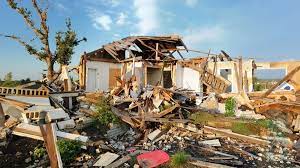Natural disasters can strike at any time, leaving a trail of destruction in their wake. From hurricanes and earthquakes to floods and wildfires, these catastrophic events can cause immense damage to homes and properties. In the United States, where natural disasters are a frequent occurrence, having adequate insurance coverage is crucial for homeowners and renters alike. However, navigating the world of natural disaster insurance can be overwhelming, with various policies and terms to understand.
This guide aims to demystify the complexities of natural disaster insurance in the USA, providing you with the knowledge and tools necessary to make informed decisions about your coverage. Whether you’re a first-time homeowner or a seasoned renter, this article will equip you with the information needed to protect yourself against the financial burdens that often accompany these devastating events. So let’s dive in and explore everything you need to know about natural disaster insurance in the USA.
Understanding Natural Disasters and Insurance Coverage
Natural disasters can strike at any time, leaving behind a trail of destruction and devastation. From hurricanes and earthquakes to floods and wildfires, these events can cause significant damage to homes and properties. That’s where natural disaster insurance comes into play.
Understanding natural disasters and insurance coverage is crucial for homeowners in the USA. This type of insurance provides financial protection against the losses caused by natural calamities. It helps homeowners recover from the aftermath of these events by providing funds for repairs or rebuilding.
When it comes to natural disaster insurance coverage, it’s important to know what is included in your policy. Typically, these policies cover damages caused by events such as hurricanes, tornadoes, earthquakes, floods, wildfires, and even volcanic eruptions. However, it’s essential to carefully review your policy to understand the specific coverage limits and exclusions.
Insurance coverage for natural disasters can vary depending on factors such as location, property value, and the level of risk associated with the area. For example, if you live in a high-risk flood zone or earthquake-prone region, your insurance premiums may be higher compared to someone living in a low-risk area.
In addition to understanding what is covered by your policy, it’s also important to be aware of any additional coverage options that may be available. Some policies offer optional coverage for things like debris removal or loss of use expenses if you are unable to live in your home during repairs.
By understanding natural disasters and insurance coverage, you can make informed decisions when choosing a policy that suits your needs. It’s crucial to assess your risks based on your location and consider the potential costs involved in repairing or rebuilding after a disaster strikes.
In the next section, we will explore the different types of natural disaster insurance available in the USA.
Types of Natural Disaster Insurance in the USA
Natural disasters can strike at any time, and being prepared is crucial. In the United States, there are several types of natural disaster insurance policies available to homeowners and renters. These policies provide coverage for various types of natural disasters, ensuring that you are financially protected in the event of a catastrophe.
One common type of natural disaster insurance is flood insurance. This policy covers damages caused by flooding, which can occur due to heavy rain, hurricanes, or even melting snow. It is important to note that flood insurance is not typically included in standard homeowner’s insurance policies and must be purchased separately through the National Flood Insurance Program (NFIP) or private insurers.
Another type of natural disaster insurance is earthquake insurance. This policy provides coverage for damages caused by earthquakes, which can be particularly devastating in certain regions of the country. Earthquake insurance is also not typically included in standard homeowner’s insurance policies and must be purchased as a separate policy.
In addition to flood and earthquake insurance, there are other types of natural disaster coverage available such as hurricane insurance, tornado insurance, wildfire insurance, and more. These policies provide financial protection against damages caused by specific types of natural disasters that are prevalent in certain areas.
It is important to understand that the availability and cost of these policies may vary depending on your location and the level of risk associated with specific natural disasters in your area. Therefore, it is essential to research and consult with an experienced insurance agent who can guide you in choosing the right type and amount of coverage for your needs.
By having a comprehensive understanding of the different types of natural disaster insurance available in the USA, you can make informed decisions about protecting your home and belongings from potential damage caused by unforeseen events. Remember, investing in these policies can provide peace of mind knowing that you are financially prepared for whatever Mother Nature may throw your way.
Factors Affecting Insurance Coverage and Premiums
When it comes to natural disaster insurance, there are several factors that can affect both the coverage you receive and the premiums you pay. Understanding these factors is crucial in order to make informed decisions about your insurance policy.
One of the main factors that can impact your coverage is the location of your property. Certain areas in the United States are more prone to specific types of natural disasters, such as hurricanes, earthquakes, or wildfires. Insurance companies take this into consideration when determining coverage options and premiums. If you live in an area with a higher risk of a particular natural disaster, you may need additional coverage or be subject to higher premiums.
Another factor that can affect your insurance coverage is the age and condition of your property. Older homes or buildings may have outdated infrastructure or materials that could make them more susceptible to damage during a natural disaster. Insurance companies may require additional inspections or recommend certain upgrades to ensure adequate coverage.
Additionally, your previous claims history can also impact your insurance coverage and premiums. If you have filed multiple claims for natural disasters in the past, insurers may view you as a higher risk and adjust your coverage accordingly. It’s important to keep track of any previous claims and consider how they might influence future insurance options.
Lastly, it’s worth noting that deductibles play a significant role in determining both coverage and premiums. A deductible is the amount you must pay out-of-pocket before your insurance kicks in. Higher deductibles often result in lower premium costs but also mean you’ll have to cover more expenses upfront if a natural disaster occurs.
Understanding these factors will help you navigate through the complexities of natural disaster insurance and make informed decisions about the right policy for your needs. By considering location, property condition, claims history, and deductibles, you can ensure that you have appropriate coverage while managing premium costs effectively.
How to Choose the Right Natural Disaster Insurance Policy
When it comes to choosing the right natural disaster insurance policy, there are several factors that you need to consider. First and foremost, you should assess your geographical location and the specific risks associated with it. Different regions in the USA are prone to different types of natural disasters, such as hurricanes, earthquakes, floods, or wildfires. Understanding the likelihood of these events occurring in your area will help you determine which types of coverage you should prioritize.
Next, it’s important to carefully review the terms and conditions of each policy. Pay close attention to what is covered and what is excluded. Some policies may only cover certain types of natural disasters or have limitations on coverage amounts. Make sure that the policy aligns with your needs and provides adequate protection for your property.
Additionally, consider the financial stability and reputation of the insurance company offering the policy. You want to choose a reliable insurer that has a good track record of handling claims efficiently and providing excellent customer service.
Lastly, don’t forget to compare premiums from different insurers. While cost shouldn’t be the sole determining factor, it’s essential to find a balance between affordability and comprehensive coverage.
By taking these factors into account when choosing a natural disaster insurance policy, you can ensure that you are adequately protected in case of any unforeseen events. Remember, investing time in research now can save you from potential financial hardships later on.
Recommended Posts:
- Importance of Life Insurance You Must Know
- 5 In-Demand Careers for Students to Consider
- How to Turn An Internship Opportunity Into a Full Time Job Offer
- Top 6 Study Apps and Tools for Students
What to Do in the Event of a Natural Disaster: Filing an Insurance Claim
In the unfortunate event of a natural disaster, filing an insurance claim can be a daunting task. However, it is crucial to take immediate action to ensure that you receive the necessary financial assistance to recover from the damages. Here are some important steps to follow when filing an insurance claim after a natural disaster.
First and foremost, prioritize your safety and well-being. Make sure you and your loved ones are in a safe location before contacting your insurance company. Once you have ensured your safety, reach out to your insurer as soon as possible. Most insurance policies require prompt reporting of damages, so don’t delay in notifying them about the situation.
When speaking with your insurance company, be prepared to provide detailed information about the damages incurred during the natural disaster. Take photographs or videos of the affected areas as evidence for your claim. Document any personal belongings that have been damaged or lost as well.
It is also important to keep all receipts related to repairs or temporary accommodations during the recovery process. These expenses may be eligible for reimbursement under your policy.
Once you have filed your claim, stay in touch with your insurance adjuster regularly for updates on the progress of your case. Be proactive in providing any additional documentation they may request and promptly respond to their inquiries.
Lastly, if you encounter any difficulties or disputes during the claims process, don’t hesitate to seek professional help from public adjusters or legal counsel specializing in insurance claims.
Remember, filing an insurance claim after a natural disaster can be overwhelming, but by following these steps and staying organized throughout the process, you can increase your chances of receiving fair compensation for your losses.
In conclusion, understanding natural disaster insurance in the USA is crucial for homeowners and renters alike. With the increasing frequency and severity of natural disasters, having the right insurance coverage can provide peace of mind and financial protection.
Throughout this guide, we have explored the different types of natural disaster insurance available, factors that affect coverage and premiums, and how to choose the right policy for your needs. We have also discussed the importance of knowing what to do in the event of a natural disaster and how to file an insurance claim.
By being proactive and informed about your insurance options, you can ensure that you are adequately protected against the devastating effects of natural disasters. Remember, preparation is key, so take the time to review your current policy or consider obtaining one if you haven’t already done so. Stay safe and be prepared!

